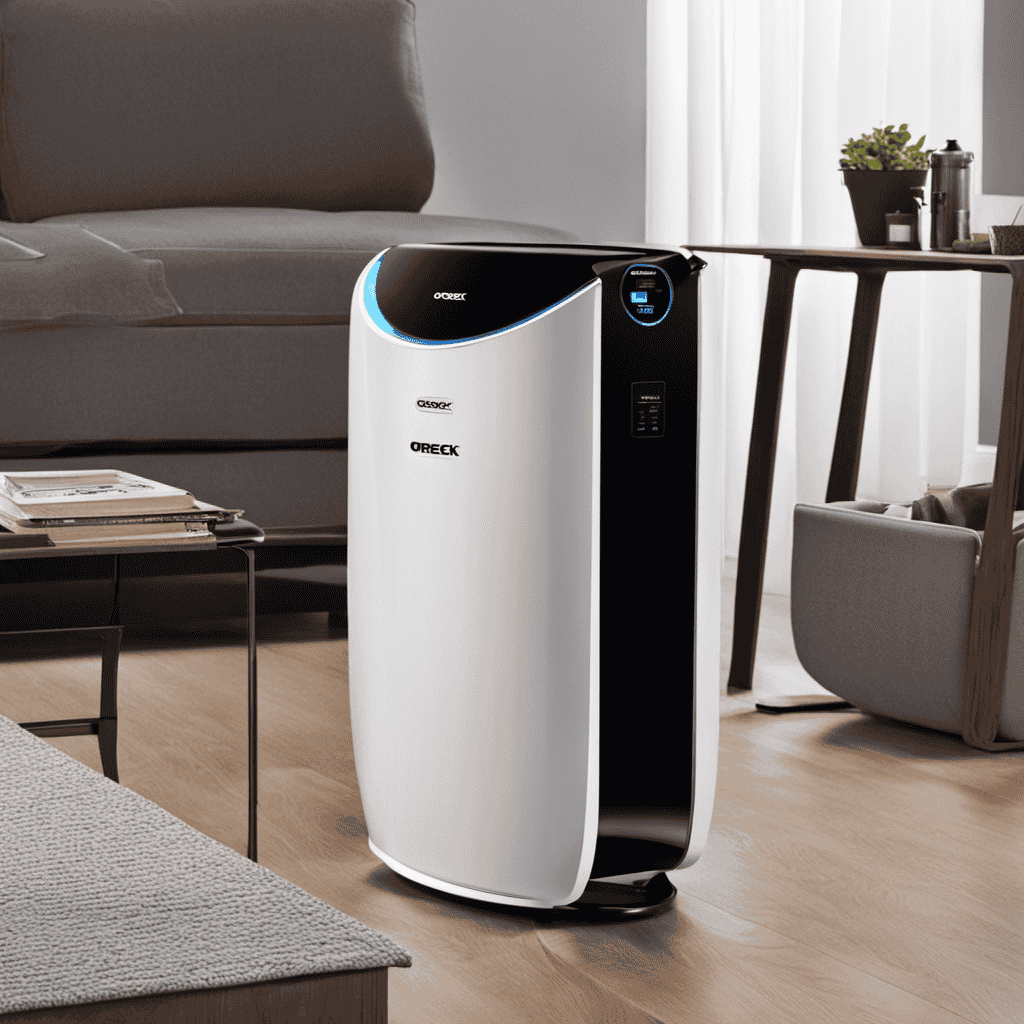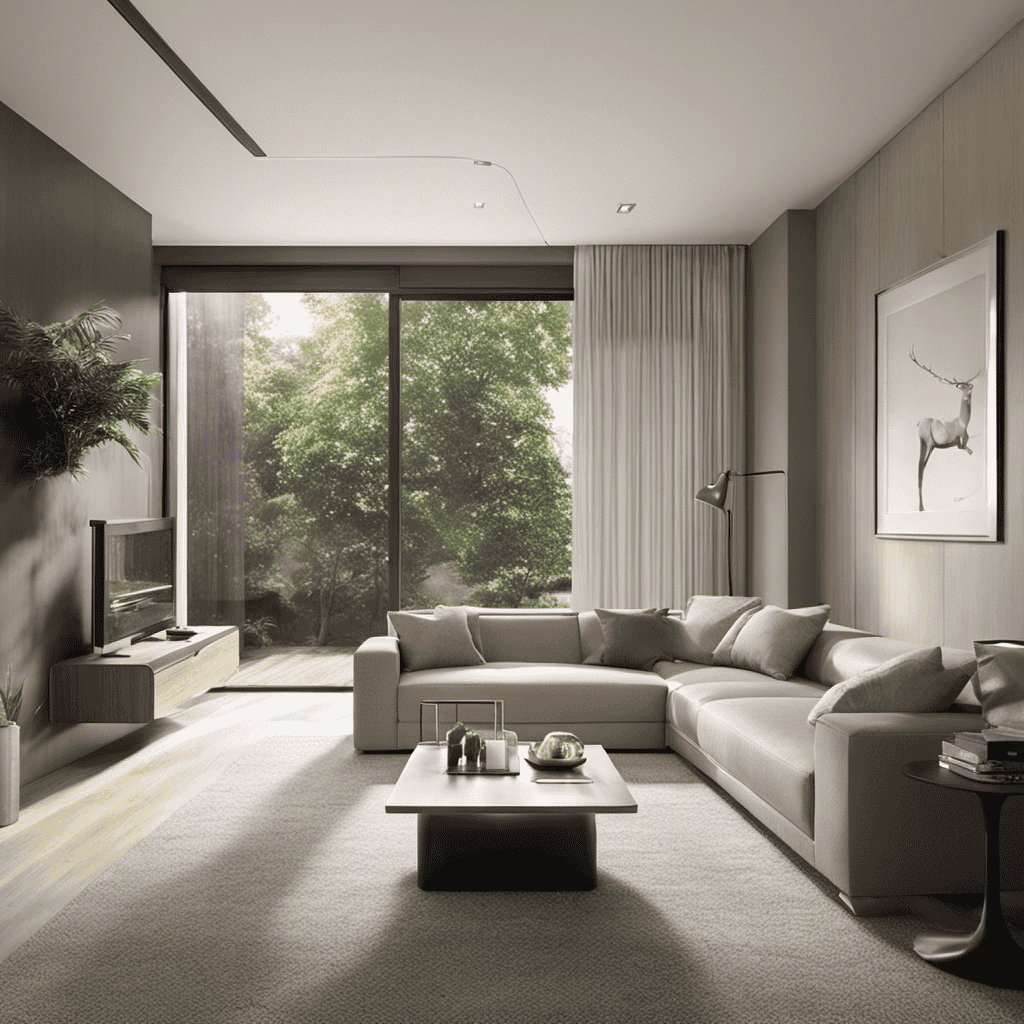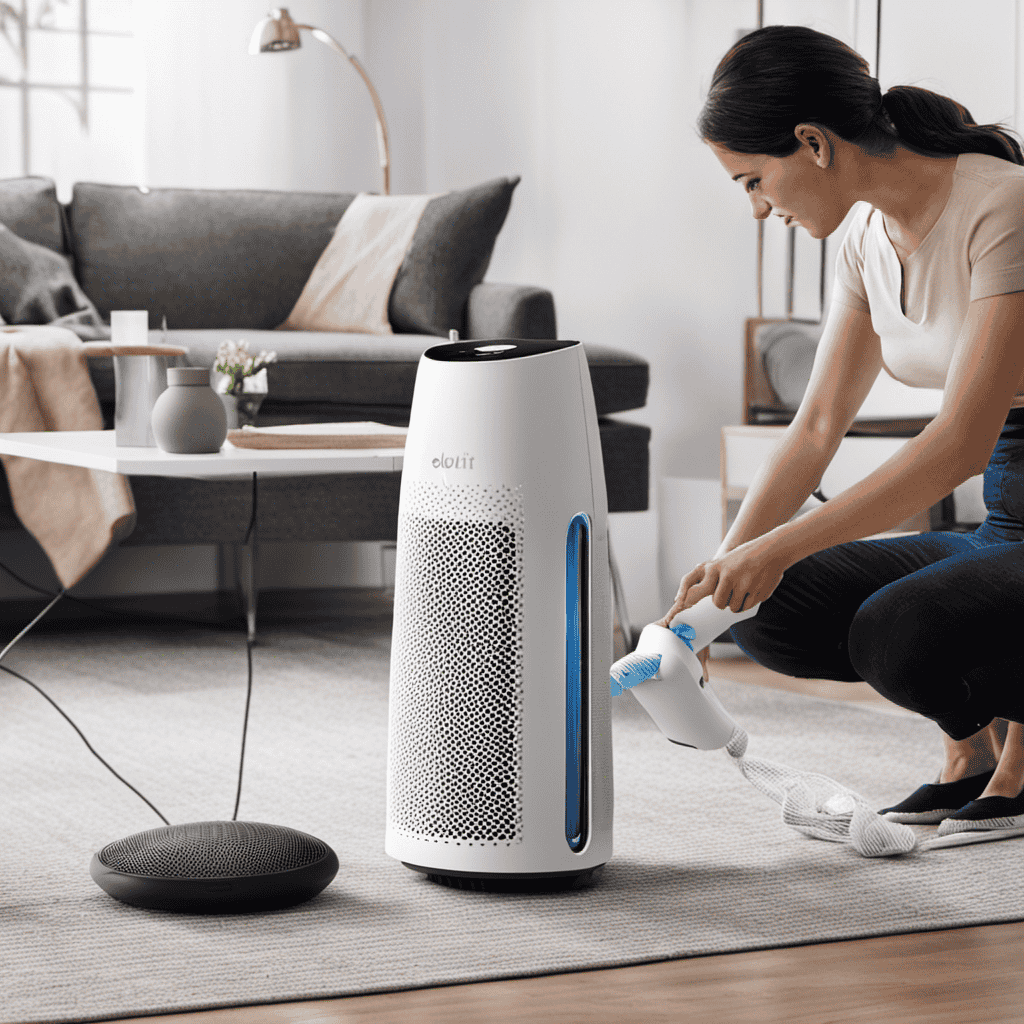As someone who is passionate about clean air, I have frequently asked myself, “How long should I keep an air purifier running?” Well, the answer is here!
In this informative article, we will explore various factors to consider when determining the optimal usage of your air purifier. From the size of your space to the air quality in your area, we’ll cover it all.
So, let’s embark on this journey together and discover the best practices for ensuring fresh, pure air in our homes.
Key Takeaways
- Regularly cleaning and replacing filters is essential for optimal performance.
- Running the air purifier for a few hours each day maintains good air quality.
- Proper purifier size is crucial for effective air cleaning in the room.
- Running the air purifier for at least six hours a day ensures constant filtration.
Factors to Consider
There are a few factors to consider when deciding how long to run an air purifier. One important factor is purifier maintenance. Regularly cleaning and replacing filters is essential for optimal performance. Clogged filters reduce efficiency and make the purifier less effective at removing pollutants.
Another factor to consider is energy consumption. Running an air purifier continuously can increase your electricity bill. To minimize energy usage, you can set a timer or use the purifier only when necessary, such as during peak pollution hours or when you’re in the room.
It’s important to strike a balance between purifier maintenance and energy consumption to maximize effectiveness while minimizing costs.
Now, let’s move on to the recommended daily usage of air purifiers.
Recommended Daily Usage
The recommended daily usage for an air purifier is typically determined by factors such as room size and air quality. It is important to consider the size of the room when determining how long to run your air purifier. Larger rooms will require more time for the purifier to effectively clean the air.
Additionally, the purifier’s capacity is another important factor to consider. The capacity refers to the amount of air the purifier can clean in a given time. If the purifier has a higher capacity, it will be able to clean the air more efficiently and quickly.
It is recommended to run the air purifier for a few hours each day in order to maintain good air quality in your room.
The Size of Your Space
When it comes to choosing an air purifier, considering the size of your space is crucial. Room dimensions play a significant role in determining the appropriate purifier for your needs.
A larger room will require a purifier with a higher CADR (Clean Air Delivery Rate) to effectively clean the air, while a smaller room may require a smaller purifier with a lower CADR.
Additionally, the air quality in your space should also be considered. Rooms with higher levels of pollutants may require a more powerful purifier to efficiently remove contaminants.
Room Dimensions and Purifier
To effectively clean the air in your room, consider the dimensions and choose an air purifier accordingly. The size of your room plays a crucial role in determining the effectiveness of an air purifier. A purifier that is too small for the room may not be able to filter the air properly, while one that is too large may consume unnecessary energy. Here is a table to help you choose the right air purifier based on your room dimensions:
| Room Size | Recommended Purifier Size |
|---|---|
| Small | Up to 200 square feet |
| Medium | 200-400 square feet |
| Large | 400-800 square feet |
| Extra Large | Over 800 square feet |
Proper maintenance of your air purifier is also essential for optimal performance and energy consumption. Regularly cleaning or replacing filters and keeping the unit free from dust and debris will ensure that it continues to clean the air effectively while minimizing energy usage.
Air Quality and Size
Choosing the right size air purifier based on the dimensions of your room is crucial for effective air cleaning. The size of your room directly affects the air purifier’s effectiveness in removing airborne pollutants. To ensure optimal performance, it’s important to match the purifier’s capacity to the room size.
A purifier that is too small for the room will struggle to clean the air effectively, while one that is too large may not efficiently circulate the air. When determining the appropriate size, consider the square footage of your room. Most air purifiers come with a recommended room size for optimal performance.
The Air Quality in Your Area
The air quality in your area can greatly impact the effectiveness of an air purifier. It is important to consider the level of air pollution in your surroundings when deciding to use an air purifier.
By looking at air pollution data, you can determine the severity of pollution in your area and understand how it may affect your health. High levels of air pollution can lead to various health problems, including respiratory issues, allergies, and even cardiovascular diseases.
Therefore, it is crucial to choose an air purifier that is capable of effectively filtering out the pollutants present in your specific environment. Understanding the air quality in your area will help you make an informed decision when it comes to running an air purifier and addressing specific health concerns.
Specific Health Concerns
Understanding the severity of air pollution in your area can help you address specific health concerns. When it comes to maintaining good air quality in your home, there are a few key factors to consider.
First, regular purifier maintenance is essential to ensure that your air purifier is functioning at its best. This includes cleaning or replacing filters as recommended by the manufacturer. Additionally, it’s important to be mindful of purifier noise levels, as excessive noise can be disruptive and affect your overall well-being. By staying on top of maintenance and selecting a purifier with low noise levels, you can create a healthier environment in your home.
Now, let’s dive into how air pollution can contribute to allergies and asthma.
Allergies and Asthma
When it comes to ensuring effective purifier run-time and air quality improvement, there are a few key points to consider.
First, it’s important to understand that the duration of time you run your air purifier can greatly impact its effectiveness.
Secondly, the air quality in your home can greatly benefit from using a purifier consistently and for extended periods.
Lastly, by understanding the relationship between run-time and air quality improvement, you can make informed decisions on how to optimize the performance of your purifier.
Effective Purifier Run-Time
To effectively purify the air, you should run the air purifier for at least six hours a day. This ensures that the air is constantly being filtered and any pollutants or allergens are removed.
However, the run time of an air purifier can be influenced by several factors. One factor is the size of the room. Larger rooms may require a longer run time to effectively clean the air.
Another factor is the level of pollution in the air. If the air is heavily polluted, the air purifier may need to run for longer periods to remove all the contaminants.
Additionally, the energy efficiency of the air purifier can also affect the run time. More energy-efficient models may be able to operate for longer periods without consuming excessive electricity.
Air Quality Improvement?
The size of the room and the level of pollution in the air can greatly influence the amount of time an air purifier needs to be running in order to effectively improve indoor air quality.
When it comes to improving indoor air quality, air purification offers a multitude of benefits. Not only does it remove harmful pollutants and allergens from the air, but it also helps to reduce odors and freshen the overall atmosphere. By capturing and eliminating particles such as dust, pet dander, and pollen, air purifiers create a healthier living environment.
Additionally, air purification can be especially beneficial for individuals with allergies or respiratory conditions, as it helps to alleviate symptoms and improve overall respiratory health.
Therefore, understanding the size of your space and the level of pollution is crucial in determining how long you should run your air purifier to effectively improve the air quality.
Pets and Pet Dander
Pets and pet dander can be a major factor to consider when determining how long you should run an air purifier. As someone who has struggled with pet allergies, I understand the importance of keeping pet hair and dander under control.
Here are some key points to consider:
-
Pet allergies: If you or someone in your household suffers from pet allergies, it is crucial to run the air purifier consistently to minimize the allergens in the air.
-
Pet hair control: Running the air purifier for longer periods can help remove pet hair and dander from the air, reducing the amount that settles on furniture and floors.
By running the air purifier consistently, you can create a cleaner and healthier environment for both you and your pets.
Now, let’s dive into the next section about smoking and odors.
Smoking and Odors
If you’re a smoker or have to deal with unpleasant odors, using an air purifier can help improve air quality in your home.
Air purifiers are designed to remove smoke particles and eliminate odors, making the air cleaner and fresher to breathe.
These devices work by using filters and sometimes additional technologies like activated carbon or ozone to trap and neutralize the smoke and odor molecules.
When using an air purifier for smoke elimination or odor removal, it is important to run it continuously for optimal results.
The length of time will depend on the severity of the smoke or odor issue, but it is recommended to run the air purifier for at least a few hours, and preferably overnight, to effectively clean the air and remove the unwanted smells.
Pollen and Seasonal Allergies
After discussing the effects of smoking and odors on indoor air quality, let’s move on to another common issue: pollen and seasonal allergies. As someone who suffers from allergies, I understand the importance of maintaining clean air in my home. This is where an air purifier comes in handy.
Regular maintenance of your air purifier is crucial to ensure its optimal performance. Here are a few benefits of using an air purifier:
-
Removes Pollen: Air purifiers effectively filter out pollen particles from the air, reducing allergy symptoms and providing relief during allergy season.
-
Reduces Allergens: Dust mites, pet dander, and mold spores are common allergens that can trigger allergic reactions. An air purifier helps to remove these allergens, creating a healthier indoor environment.
With proper air purifier maintenance, you can enjoy the benefits of cleaner air and alleviate the discomfort caused by pollen and seasonal allergies.
Dust and Dust Mites
When it comes to dust and dust mites, there are several key points to consider.
Firstly, dust mites are a common allergen and can be found in bedding, carpets, and furniture. To prevent dust mites, it is important to regularly clean and vacuum these areas, as well as wash bedding in hot water.
Secondly, using an air purifier can help improve air quality by capturing and removing dust particles and allergens from the air. The frequency of using an air purifier depends on factors such as the size of the room, the level of dust and allergens present, and individual sensitivity to allergens.
Lastly, it is recommended to follow the manufacturer’s guidelines and adjust usage accordingly to maintain optimal air quality.
Dust Mite Prevention
Running an air purifier can help reduce dust mite allergens in your home. Dust mites are microscopic creatures that thrive in warm and humid environments, and their droppings can trigger allergic reactions and respiratory symptoms. To prevent allergies and reduce respiratory symptoms caused by dust mites, consider the following:
- Keep humidity levels below 50% to discourage dust mite growth.
- Wash bedding and stuffed animals regularly in hot water to kill dust mites.
- Encase mattresses and pillows in allergen-proof covers to prevent dust mites from entering.
- Vacuum carpets and upholstered furniture frequently to remove dust mite allergens.
By incorporating these preventive measures and running an air purifier, you can significantly reduce dust mite allergens in your home, providing a safer and healthier environment for you and your family.
This improvement in air quality will have a positive impact on your overall well-being.
Air Quality Improvement
To improve the air quality in your home, you can take several steps.
- Open windows to allow fresh air to circulate.
- Use natural air fresheners to avoid harsh chemicals.
- Regularly clean ventilation systems to remove dust and debris.
Another important aspect to consider is the size of the room and the proper maintenance of air filters.
- Choose an air purifier that is suitable for the square footage of the area.
- A purifier that is too small may not effectively clean the air, while one that is too large may use unnecessary energy.
Additionally, regularly replacing air filters is crucial for optimal performance.
- Clogged filters can hinder the purifier’s ability to capture pollutants and allergens.
- Follow the manufacturer’s recommendations for filter replacement.
Taking these steps will help ensure healthier indoor air quality for you and your family.
Purifier Usage Frequency
Now that we understand how air quality can be improved with an air purifier, let’s discuss how often we should run it. Proper usage frequency is crucial for maintaining optimal air quality and minimizing energy consumption. Here are some important points to consider:
-
Purifier Maintenance:
-
Regularly clean the filters: Dust and debris can accumulate over time, reducing the purifier’s effectiveness. Cleaning the filters ensures optimal performance.
-
Replace filters when necessary: Depending on the manufacturer’s recommendations, filters may need to be replaced periodically to maintain optimal air purification.
-
Energy Consumption:
-
Determine your needs: Assess the air quality in your area and your specific requirements to determine how often you need to run the purifier.
-
Use a timer: Set a timer to run the purifier during peak hours when air quality is typically lower, reducing unnecessary energy consumption during times of better air quality.
Mold and Mildew
Using an air purifier can help prevent the growth of mold and mildew in your home. Mold and mildew thrive in environments with high humidity and moisture levels.
By running an air purifier, you can effectively control the moisture in your home, reducing the risk of mold and mildew growth. Air purifiers work by filtering out airborne contaminants, including mold spores, preventing them from settling and growing on surfaces.
To effectively prevent mold and mildew, it is important to choose an air purifier with a HEPA filter, as these filters can capture even the smallest particles. Additionally, it is crucial to properly maintain your air purifier by regularly changing the filters and cleaning the unit to ensure optimal performance in mold prevention.
Viruses and Bacteria
Running an air purifier with a HEPA filter can effectively filter out viruses and bacteria in your home. This is one of the major benefits of using an air purifier. Not only does it remove allergens and pollutants from the air, but it also helps to create a healthier environment by eliminating harmful microorganisms.
Here are some key points to consider when it comes to viruses and bacteria and the benefits of using an air purifier:
- The HEPA filter in an air purifier can trap and remove airborne viruses and bacteria, reducing the risk of respiratory infections.
- Air purifiers with UV-C light technology can kill viruses and bacteria that are captured by the filter, further enhancing the purification process.
Chemical Pollutants
When it comes to chemical pollutants, it’s important to consider safe exposure levels. Knowing the acceptable limits can help determine the effectiveness of an air purifier in removing these pollutants from the air.
Additionally, understanding the duration required to achieve clean air is essential for maintaining a healthy indoor environment.
Safe Chemical Exposure Levels
There aren’t any specific guidelines on safe chemical exposure levels while running an air purifier. However, there are a few things to consider when it comes to ensuring the safety and effectiveness of your air purifier in reducing chemical pollutants:
-
Choose an air purifier with an activated carbon filter: This type of filter is specifically designed to trap and remove chemical pollutants from the air.
-
Run the air purifier for a sufficient amount of time: The effectiveness of an air purifier in reducing chemical pollutants depends on the duration it runs. It is recommended to run the air purifier continuously or for at least a few hours each day to ensure optimal purification.
Air Purifier Effectiveness
Using an air purifier with an activated carbon filter can significantly improve its effectiveness in reducing chemical pollutants. The activated carbon filter has the ability to trap and absorb harmful chemicals, such as volatile organic compounds (VOCs), formaldehyde, and other toxic gases.
This type of filter is especially useful in environments where chemical pollutants are a concern, such as offices with printers or homes near industrial areas. However, it is important to note that regular maintenance is recommended to ensure optimal performance. This includes cleaning or replacing the filter according to the manufacturer’s instructions.
Additionally, noise levels should be taken into consideration when choosing an air purifier. Some models are designed to operate quietly, making them more suitable for bedrooms or areas where noise is a concern.
Duration for Clean Air?
When it comes to ensuring clean air in your home, the duration for running an air purifier is crucial. The recommended usage depends on various factors, such as the size of the space, the level of pollutants, and personal preferences.
Generally, running an air purifier continuously can provide the best results, ensuring that the air remains clean at all times. However, if you prefer to save energy or if the air quality is relatively good, you can consider running it for a few hours a day.
It’s important to note that air purifiers are most effective when the doors and windows are closed. By following the recommended usage guidelines, you can enjoy clean and fresh air in your home.
Now, let’s explore how air purifiers can be beneficial in high pollution areas.
High Pollution Areas
If you live in a high pollution area, you should consider running an air purifier for longer periods of time. High levels of pollution can have detrimental effects on your health, so it’s important to take preventive measures. Running an air purifier helps to filter out harmful pollutants and improve the air quality in your home. However, it’s crucial to maintain your air purifier properly to ensure its effectiveness. Here are some maintenance tips for your air purifier:
| Maintenance Tips | Frequency |
|---|---|
| Replace filters | Every 3-6 months |
| Clean exterior | Once a month |
| Clean pre-filter | Every 2 weeks |
| Check performance | Regularly |
Nighttime Usage
Running an air purifier at night can significantly improve the air quality in your home and promote better sleep. Here are a few reasons why nighttime usage of an air purifier is beneficial:
-
Removes allergens and pollutants: Air purifiers work by filtering out airborne particles such as dust, pollen, pet dander, and mold spores. Using them at night can help reduce these allergens, allowing you to breathe cleaner air while you sleep.
-
Reduces odors: If you have pets, cooking odors, or live in a polluted area, running an air purifier at night can help eliminate these unwanted smells, creating a more pleasant and fresh environment.
-
Energy consumption: Many modern air purifiers have energy-saving features, allowing them to operate at a low energy level during the night. This helps minimize energy consumption while still providing efficient air purification.
What Factors Should I Consider When Determining How Long to Run an Air Purifier?
When establishing a running an air purifier schedule, consider the room size, air quality, and the specific purifier model. Larger rooms or areas with poor air quality may require longer purifier run times. Some models come with built-in air quality sensors to automatically adjust the running time.
Frequently Asked Questions
Can an Air Purifier Completely Eliminate All Viruses and Bacteria in the Air?
An air purifier can effectively reduce the presence of viruses and bacteria in the air. However, it cannot completely eliminate them. Regular maintenance and cleaning of the purifier are essential for optimal performance.
How Often Should I Clean or Replace the Filters in My Air Purifier?
I replace and clean my air purifier filters regularly to maintain their efficiency. It’s important to check the manufacturer’s instructions for specific guidelines. Keeping the filters clean ensures optimal performance and healthier air.
Are There Any Side Effects or Risks Associated With Using an Air Purifier?
Negative side effects and potential health risks can be associated with using an air purifier. It’s important to research and understand the specific model you have to ensure its safety and effectiveness.
Can an Air Purifier Help With Reducing Indoor Humidity Levels?
An air purifier can help reduce indoor humidity levels by filtering out excess moisture in the air. It’s important to choose the right air purifier for your home and consider the benefits it offers for allergies.
Can I Use Multiple Air Purifiers in Different Rooms of My House for More Effective Air Purification?
Using multiple air purifiers in different rooms can be beneficial for more effective air purification. It helps to maintain indoor air quality and reduces the need for constant air purifier maintenance.
Conclusion
In conclusion, determining how long to run an air purifier depends on various factors. These factors include the size of your space, air quality, specific health concerns, and the presence of pollutants.
It is recommended to use an air purifier daily, especially in high pollution areas, to ensure clean and healthy air. However, there is no specific duration that applies to everyone.
Ultimately, the goal is to create a safe environment that promotes well-being and peace of mind. So, let the purifier work its magic and breathe in the freshness it offers.










